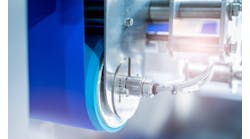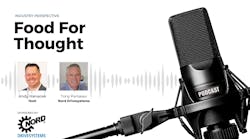To get a conveyor moving, a motor and a power transmission device have to work together as a unit. Could they actually be the same unit?
The standard setup to power a conveyor is a conventional electric motor and a gearbox – a device that mechanically transforms the fast rotation of the motor’s shaft into the torque needed to move a conveyor belt or chain. (For this reason, it is sometimes called a “speed reducer.”) But an alternative is to use a gearmotor or drum motor – all-in-one units that combine the motor and power transmission components in one housing. Deciding which direction to take means balancing a host of considerations, including initial purchase price, versatility and maintenance issues.
Perhaps the greatest advantage of the conventional motor-and-gearbox setup is its ubiquity. It uses off-the-shelf components that can be mixed and matched for the best price, both initially and as replacements. Usually, the major decision is what kind of gearbox to use, which brings up questions of durability, sanitation and efficiency.
The major alternatives in gearboxes are worm gears and helical gears. The former tend to be smaller, which makes them easier to install, and have relatively few moving parts, which cuts down on both original and replacement expense. Their major drawback is their lack of efficiency: They can lose up to 50% of the motor’s power. Helical gear reducers are bulkier but can maintain up to 98% of the motor’s efficiency.
Conventional setups power conveyors by pairing an electric motor with a gearbox. Photo: Multi-Conveyor
A common configuration is to mount the motor and the gearbox at right angles. They’re usually mounted at intervals, connected to the conveyor’s driveshaft. If a shaft protrudes from the gearbox, it has to be placed above or below the conveyor line to mesh with the sprocket; if it has a hollow shaft, it can be connected directly to the sprocket or other drive mechanism. Motor-and-gearbox placement has implications for ease of sanitation and worker accessibility to the line.
Easy to replace
Probably the biggest advantage for the conventional setup is the ease of replacement. “If the motor itself should falter or become incapacitated, the operator can simply unbolt and replace the C-face motor, saving the reducer, instead of replacing the entire gearmotor,” says the application engineering manager of Multi-Conveyor.
Gearmotors, on the other hand, have their own advantages. They are easier to install than conventional setups and, as dedicated units, they often have better energy efficiency. They usually take up less space than conventional setups – an important consideration on a crowded line.
They can be designed for easier cleaning, especially drum motors, which are situated at the end of the conveyor belt loop. Because of their all-in-one design and round shape, they don’t present many surfaces that are liable to retain debris. And they don’t usually use large sprockets, removing another source for filth to accumulate.
One of the biggest differences between gearmotors and motor-and-gearbox setups is in the approach to maintenance. Powering conveyors is a ubiquitous use for motors in food and beverage plants, and it’s one where the end user usually takes direct responsibility for maintenance, instead of farming it out to an equipment manufacturer or other third party.
Maintenance with motors and gearboxes has to be done on a fairly regular basis, especially with gearbox lubrication, although that often is handled by oil wells attached to the box. Gearmotors are usually self-lubricating and require little ongoing maintenance. The downside is that if a gearmotor malfunctions, usually the whole unit has to be replaced.
Another issue with gearmotors is heat buildup. Because the unit is enclosed, heat does not have as much of a chance to dissipate as it would from an exposed motor and gearbox. If the conveyor line is to be washdown-resistant, venting in the gearmotor’s shell must be minimal or nonexistent, posing a further problem with heat dissipation. In addition, most conveyor motors are fan-cooled; this is usually not an option for gearmotors and drum motors, where all the components are internal.
Drum motors provide all-in-one power transmission in an easy-to-clean shell. Photo: VDG
Cooling methods
Drum motors from VDG, the leading manufacturer, use oil to transfer heat from the motor to the drum shell, whence it dissipates to the belt. A whitepaper from VDG concedes that “cooling of the drum motor through the oil submersion is not as effective as the method of fan cooling of a standard conveyor motor” and that “without sufficient heat dissipation, oil temperature rises, oil viscosity decreases and may not provide adequate lubrication, resulting in premature mechanical component failure.”
The major heat source for an enclosed motor is the motor itself, with the mechanical transmission component adding about 15% of the total heat. Motors overheat because the current density of the windings in their stators and the magnetic density of the rotors generate excessive heat. If these two densities are too low, however, the motor won’t be able to do the required amount of work.
VDG has addressed this problem by developing a “sweet spot” of lamination thickness for the windings and materials for the inner components of its motor that gives it enough power without excessive heat.
Another advantage of drum motors is that it’s easier to achieve varying conveyor speeds with them than with conventional motors. This is because there’s usually only one per conveyor.
Variable frequency drives can regulate conveyor speeds by altering the current they feed to an AC motor. Photo: Nord Drivesystems
To get a conventional AC motor to change speeds, it’s necessary to alter the frequency of the current that powers it. This requires variable frequency drives, which are relatively expensive and fragile. Putting a VFD with every motor in a conventional setup would be cost-prohibitive. Even wiring all of them to a single drive would be problematic, since current dissipates over distances. VDG, on the other hand, can furnish models with built-in VFDs protected against washdown.
Trust issues
Perhaps the biggest reason that many end users hesitate to buy gearmotors and drum motors is the fear of being captive to a single manufacturer. Motors and gearboxes can be mixed and matched; as they wear out, end users have competing suppliers to buy replacements from. When gearmotors need repair or replacement, the manufacturer is often the only available source.
Alex Kanaris, president of VDG, acknowledges that “having a single supplier can be an issue with some customers for now” but adds that “for industries to tie themselves to one supplier is not uncommon today.” He also points out that customers often have the option of substituting a different gearmotor or even going to a conventional motor-and-gearbox setup.
Gearmotors and motor-and-gearbox combos have their respective advantages. Judicious selection among the option will maximize the efficiency and reliability of material handling over the life of a conveyor system.


